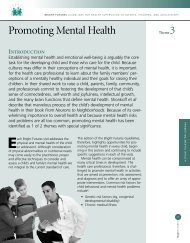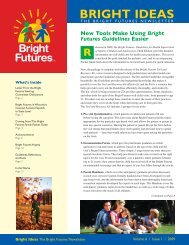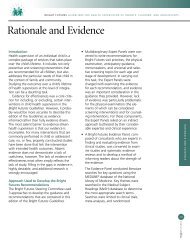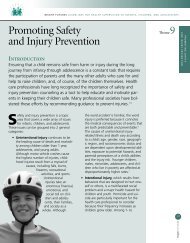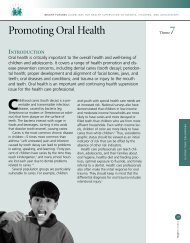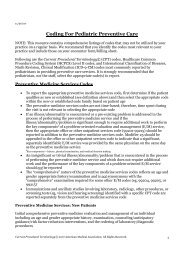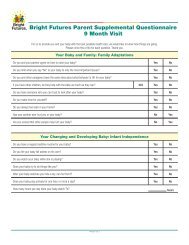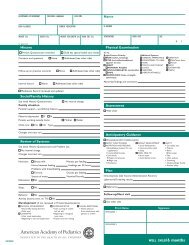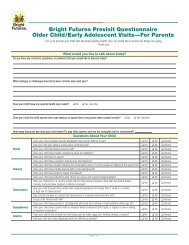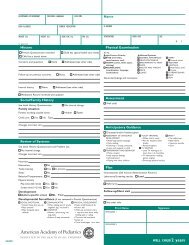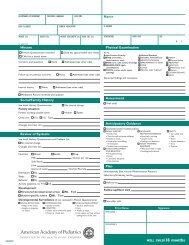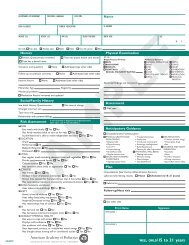POCKET GUIDE - Bright Futures - American Academy of Pediatrics
POCKET GUIDE - Bright Futures - American Academy of Pediatrics
POCKET GUIDE - Bright Futures - American Academy of Pediatrics
Create successful ePaper yourself
Turn your PDF publications into a flip-book with our unique Google optimized e-Paper software.
■ Does your baby receive anything else besides breast milk<br />
or infant formula?<br />
■ how do you feel about the way your baby is growing?<br />
■ Are you concerned about having enough money to<br />
buy food?<br />
■ What is the source <strong>of</strong> your drinking and cooking water?<br />
Do you use bottled or processed water?<br />
Screening and Assessment<br />
■ Measure the infant’s length, weight, and head circumference,<br />
and plot them on a standard growth chart. Deviation<br />
from expected growth patterns should be evaluated. This<br />
may be normal or may indicate a nutrition problem.<br />
■ evaluate the appearance <strong>of</strong> the infant’s skin, hair, teeth,<br />
gums, tongue, and eyes.<br />
■ Assess the infant for age-appropriate development.<br />
■ observe the parent-infant interaction, and assess parents’<br />
and infants’ responses to one another (affectionate, comfortable,<br />
distant, anxious).<br />
Anticipatory Guidance<br />
discuss with Parents <strong>of</strong> all infants<br />
Feeding practices<br />
■ Breast milk provides ideal nutrition and supports optimal<br />
growth and physical development. (exclusive breastfeeding<br />
[only breast milk] is recommended for a minimum <strong>of</strong><br />
4 months, but preferably for 6 months.)<br />
■ Feeding their infant, until age 12 months, breast milk or<br />
iron-fortified infant formula and avoiding low-iron milk<br />
(cow’s, goat’s, soy), even in infant cereal.<br />
■ Feeding their infant until he is full.<br />
■ For younger infant (up to age 3 months), signs <strong>of</strong> hunger<br />
include putting the hand to the mouth, sucking, rooting,<br />
pre-cry facial grimaces, and fussing.<br />
■ For older infant (ages 4–6 months), signs <strong>of</strong> hunger<br />
include moving the head forward to reach the spoon<br />
and swiping food toward the mouth.<br />
■ spitting up a little breast milk or formula at each<br />
feeding is normal.<br />
Food safety<br />
■ Following food safety practices for storage <strong>of</strong> expressed<br />
breast milk or open containers <strong>of</strong> ready-to-feed or<br />
concentrated formula.<br />
5<br />
<strong>Bright</strong> FUTURES<br />
Infancy



